Masaru Okuyama bespoke shoes: Review
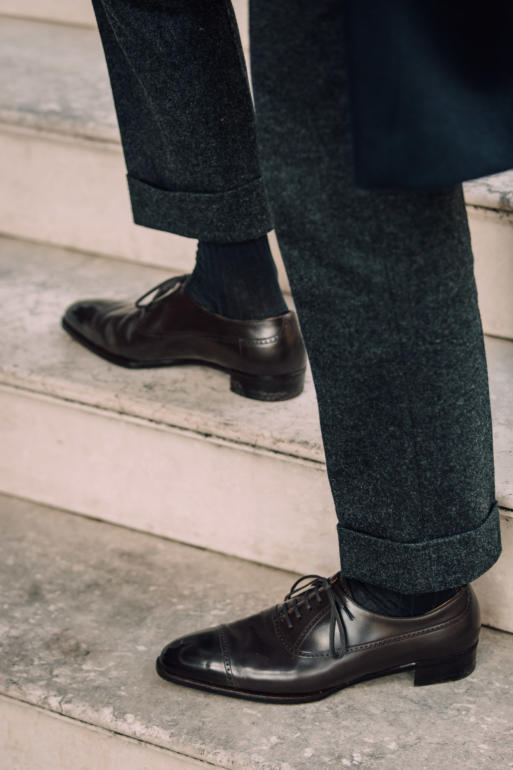
Masaru Okuyama - the Japan-trained but Hong Kong-based shoemaker - made me this pair of shoes over the past 10 months.
Their relevance is twofold. As a review of Masaru and his work, of course, but also as an experience of Japanese shoemaking, as this is my first pair from a Japanese maker.
In brief, the make is superb and the fit very good too. There are some minor issues on the fit, but overall these might be the best first bespoke pair I’ve had.
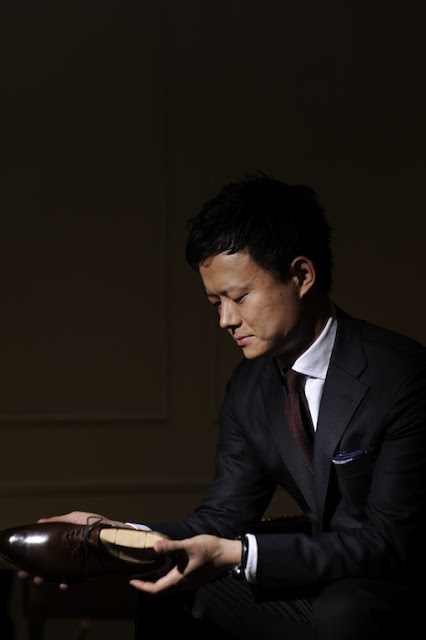
Masaru is slightly unusual among Japanese shoemakers in that he learned in Japan but - despite a few months travelling around - didn’t then train in Europe.
He was advised by Ricardo Bestetti not to waste his time starting at the bottom with a house in England, France or Italy, when he could already make everything from scratch.
He is also unusual in deciding to set up in Hong Kong (in 2010), rather than Japan. This has made him more accessible for some customers, given the number of people travelling through Hong Kong.
However, in recent years his travels have increased that accessibility more significantly. He is one of the few Japanese makers that travels to London (twice a year) - which is one reason I decided to work with him.
He also travels to Singapore, Beijing and Hanoi three times a year, and Shanghai twice a year.
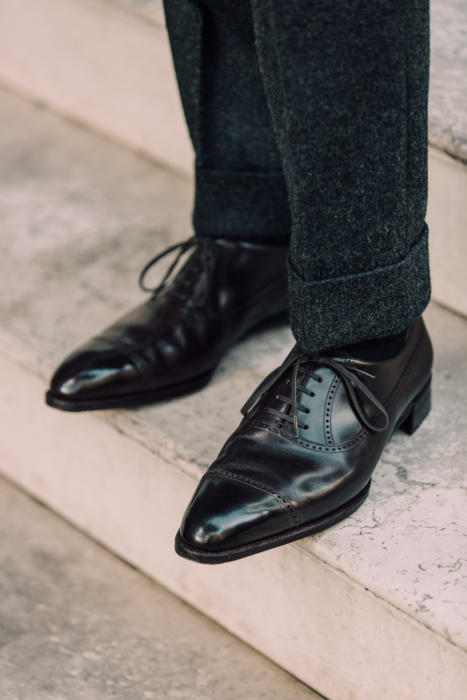
Although based in Hong Kong, Masaru’s style isn’t really influenced by it.
He is a Japanese shoemaker, and as a result tends to a finely made, slim shoe on an elongated last. He can make different styles, but he has this tendency in common with many other Japanese makers.
Those makers can also be divided up by their European influences and training of course: a simple English shoe, a flashier French one, or a longer Italian one, perhaps.
But even though there are these differences, I think it’s fair to say the Japanese as a whole have this tendency towards slim refinement.
You see that in Shoji Kawaguchi (Marquess) and Yuki Shirahama, even though one trained in England and the other in France.
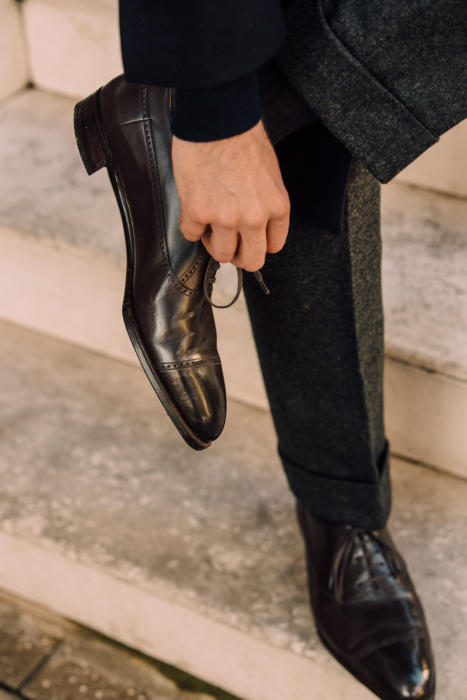
The execution of those points on my shoes is superb.
I have to say I had high expectations, but these have fulfilled them.
The way the heel cup runs smoothly into the heel itself; the slight pitch of the heel; its curve on the bottom into a bevelled waist; the consistency of the finishing all round the welt.
These are all points for the enthusiast, but it’s what you can get from a handmade shoe - and should perhaps expect from a good bespoke one.
I illustrated them (with helpful red lines) on my review of Foster & Sons bespoke.
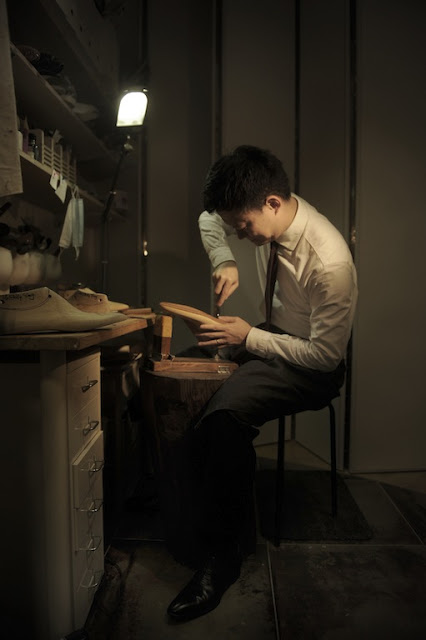
At this point in my journey through bespoke shoes, I would never expect fit to be absolutely perfect on a first pair.
It’s one of the big problems with bespoke, and something I reflected on with my second pair from Stefano Bemer.
The biggest argument for bespoke footwear is as a long-term project.
If you have one maker, and make a pair every year or two, then 20 years down the line, it will seem virtually irrelevant that the first pair wasn’t quite right. But it doesn’t feel that way if you only buy one.
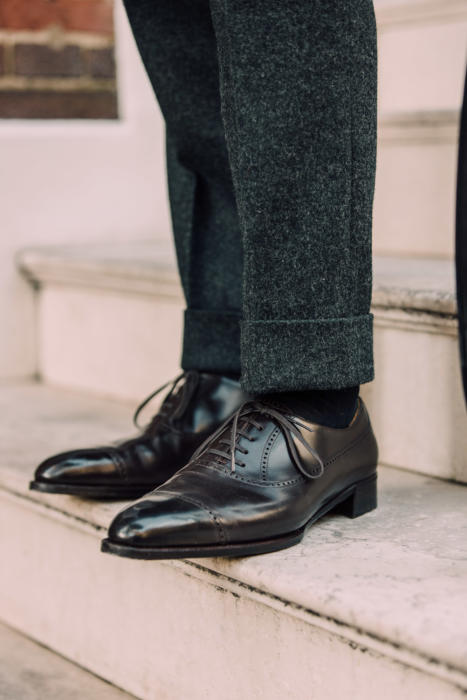
Masaru came close with this pair.
The heel shape is perfect, the toes have plenty of room to move (without the shoe itself being too wide - a delicate balance) and the arch of my foot is followed precisely.
The issues are with the vamp, where you bend the shoe as you walk. There is a little too much room here, which is causing wrinkling.
This is a delicate balance though - I have a high joint on my big toe, and when other makers have left too little room here, that has been pressed painfully.
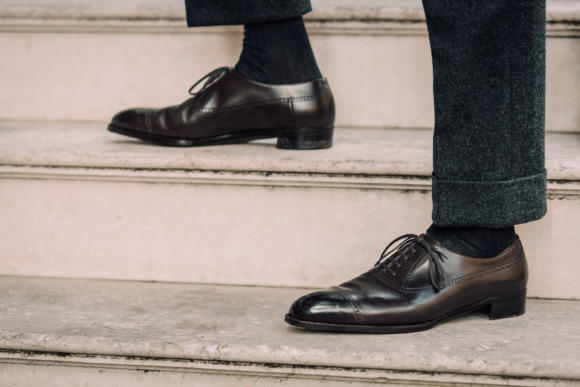
Personally I also think the wrinkling is down to the length of the shoe. Because it’s long, the vamp is creasing in almost two places. A shorter style might remove that problem.
However, Masaru will be able to diagnose it better the next time he’s in London. Although he checked the fit when he delivered the shoes to me, it will be much clearer when they’ve been worn 10 or 20 times.
A tightness on one side of the heel has already subsided, as the leather has softened.
From a style point of view, it’s also worth noting that as with a lot of bespoke makers, Masaru does no real finishing on the shoes.
They’re polished of course, in a similar colour, but there is no patina, no burnishing. This makes them look a little flat - particularly if you compare them to a ready-made shoe - but that will come in time, as I polish them myself.
I’ve already started using a little black polish on the toe cap and heel, and that will build slowly. Character will also come through the creases and little signs of wear.
Lastly, I think I made the wrong decision on the style around the heel.
This is a balmoral oxford: ‘balmoral’ referring to the horizontal seam running along the side of the shoe, rather than curving down to meet the sole.
At the back, Masaru suggested tweaking the style, so that the vertical seam on the heel is moved around to the side of the shoe.
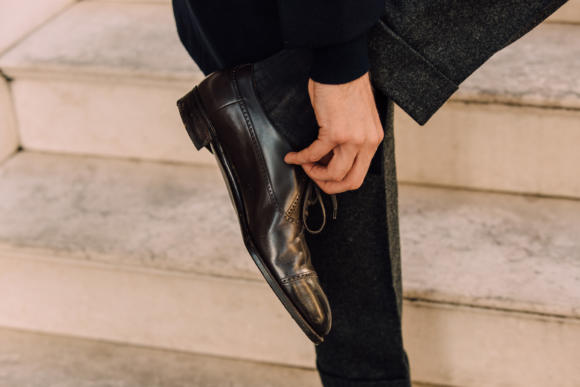
This makes the heel look cleaner (no seam); and because the seam is placed on the internal side of the shoe (between your two feet), it is also not that visible.
But when you do see that seam (as you can above) it looks of place to me. Floating; unmoored. I should have left it on the back.
Oh well. Contrary to what you might expect, I know that in the long term, that imperfection will almost make me more fond of the shoes, not less.
Masaru’s starting price for bespoke is currently HK$38,000 (£3,695). Delivery time is around 10 months.
He also now offers an MTO service, where shoes have a hand-sewn welt but outsole sewn by machine. They are based on ready-made sizes, with the ability to alter width and in-step height. It starts at HK$16,000, and delivery is four months.
You can see a full range of Masaru’s styles on his Tumblr here. There is also a nice interview with Masaru going into more detail on his background, here.
Shoes worn with trousers in charcoal 19oz flannel from Fox Brothers (FS405/A2069/33), made by Whitcomb & Shaftesbury. Experimenting with a slightly slimmer leg (19cm bottom).
Photography: shots of shoes on me, Jamie Ferguson; of shoes in isolation, Permanent Style; of Masaru, Masaru Okuyama.


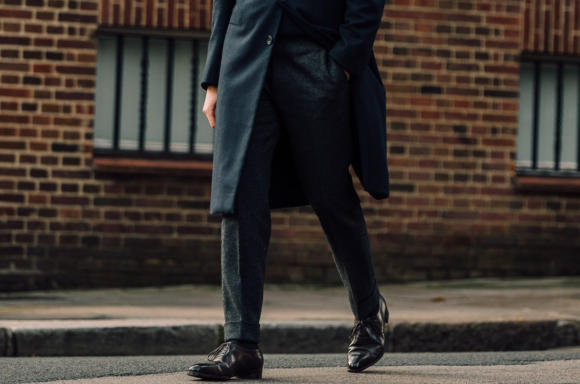
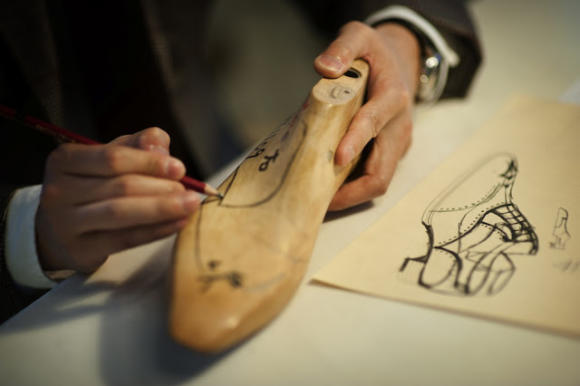
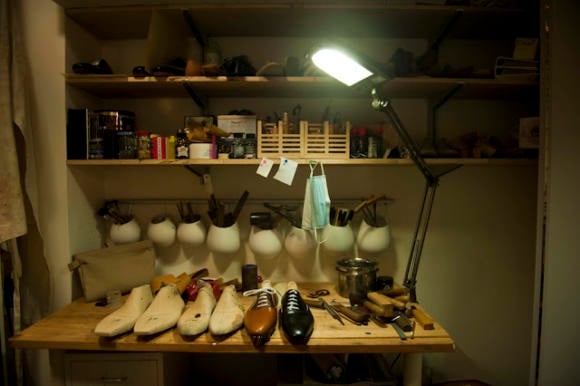
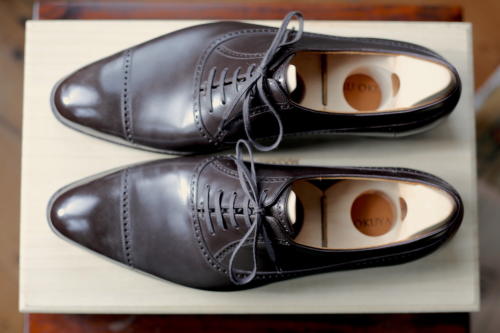
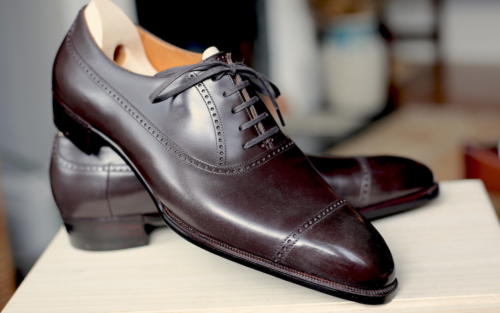
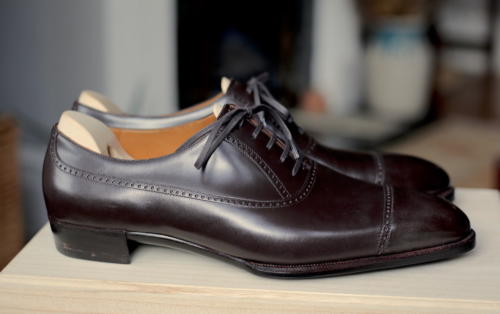
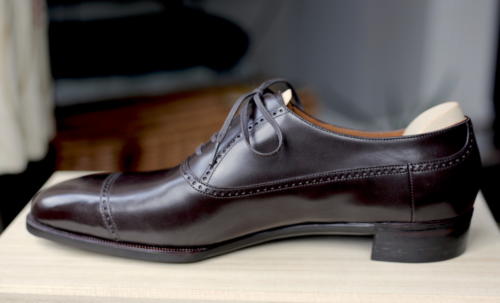
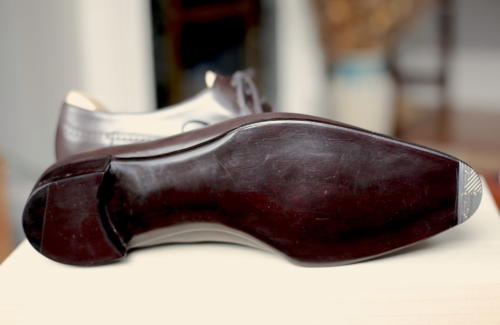
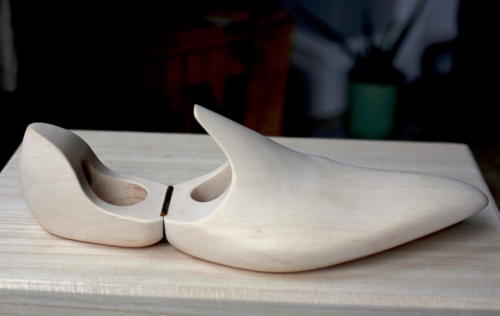
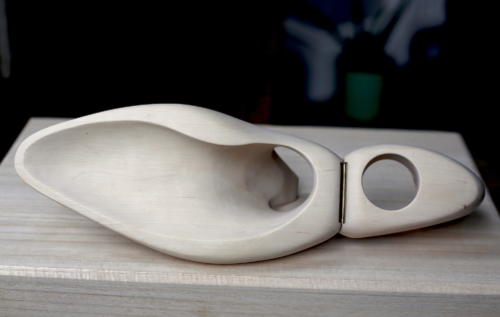


























Very elegant shoes.As you say the heel cup flows smoothly into your heel without any unsightly gap.Is this gap common when one buys Rtw footwear?I ask this because a year ago I purchased a couple of pairs of Chelsea Oxfords from Edward Green on the 82 last size 10 in their standard E fitting. I’ve noticed that there is a slight gap where the top of my heel meets the heel cup.In retrospect do you think I should have tried the same shoe but in 9 1/2 with a F wider fitting to deal with the gap problem?
I actually meant the heel cup running into the heel of the shoe – the part you walk on.
But no, there shouldn’t be a gap between the heel cup and your foot (the achilles tendon) – that does suggest the shoes might have been too big. A shoe should always hold your foot securely in the back half
Great review.
I find it interesting that he started with bespoke, expands into MTO and dreams about making RTW. A few, if not a lot, bespoke shoemakers seam to choose that route, at least if compared to tailors. Do you have any hints what thought-process or motivation goes into that?
It’s often a business decision. The long lead times and unpredictability of bespoke make it hard to run a business that way. If you have some RTW as well, it smooths out revenue with more frequent purchases, and means you always have work to keep the workshop busy.
Happy New Year.
Not sure I agree with your description of “balmoral”; this is more normally a term relating to a toe cap seam running across the front of the shoe to the welt on either side.
To you too.
Happy to be corrected, but I’m pretty sure it refers to an Oxford with a seam running horizontally along both sides.
The only small confusion can be that some Americans use it (or a ‘Bal’) to mean any Oxford.
This indeed is a balmoral, what anonymous is referring to is an extended U cap oxford.
Ok, lets try and get this one straight.
The English Balmoral shoe has no side seams; there is a stitched toe cap and a seam at the back of the shoe.
Anything beyond that is not a Balmoral, even if people refer to it as such.
As to “extended U cap Oxford”, that’s a new one on me I’m afraid.
The confusion might come from the fact that it’s more commonly used to refer to a balmoral boot, which has both – no side seam and the horizontal seam (necessarily). The balmoral shoe echoes that horizontal seam that is required on the boot.
I am with Simon on this – Balmoral refers to the horizontal seam on the shoe, if the back seam is moved inwards to the side of the heal, that doesn’t change the main horizontal seam, it is merely an adjustment to the back seam. Balmoral shoes may or may not have cap toes; Simon’s shoe is a cap toe version, while EG’s ‘Curzon’ model isn’t; it has a plain vamp.
The extended ‘U’ cap is also referred to as a short wingtip, the cap being in the shape of the U rather than straight or a full wingtip aka the brogue. It is not a common English design, i have seen mostly with Austro-Hungarian makers such as Saint Crispins, Vass etc.
“…..a full wingtip aka the brogue……”
Brogue, or broguing, refers to the punching of holes in the leather either around seams, or as a decorative feature. It has nothing to do with the name of a shoe.
Yeah, sorry, but I’m going to go with Simon on this one.
I love the trousers you’re wearing. I’m actually looking for a pair in that colour texture and weight. I don’t suppose you have any recommendations or suggestions?
For RTW? No, though see recent article comparing Anderson & Sheppard, Anglo-Italian and Drake’s, and the comments.
You’re looking for fairly heavy (13oz+) charcoal flannel
Would you recommend this heavy charcoal color over mid-grey flannels?
How are they wearing compared to you lighter 13/14/16 oz flannels? I read on the Merchant Fox site that this is more for a jacket than trousers. Why would something be more appropriate for jacketing than trousers?
No, I’d still say mid-grey is the most useful, but of course it depends what else you wear – these will become more useful the more black shoes you wear, for example.
I love this colour and look, but I would generally go for more like 13oz or 15oz flannel. There is little functional gain from the extra weight, and 15oz is more wearable.
Personally I wouldn’t wear this as a jacket, because I don’t think flannel works very well as a jacket. It isn’t open enough in the weave, or textured enough. See the jacketing section of our Guide to Cloth on why some things make better jackets.
Can a 19oz flannel suit work? Notwithstanding limited warmer month wearability, the weight looks great.
It would look superb, yes, just limited wearability as you say. Particularly indoors.
I’d suggest starting with 15oz Fox if you want something heavy
are you wearing the MB body coat here?
Yes! Full article coming next Wednesday…
Great shoes on a technical side but a really poor fit (on the vamp as you underline it). Not really convinced investing into bespoke shoes is a relevant choice when we see the result. At 4000 euros, namely the price of 6 Meccariello pairs, such flaws can’t be justified.
I’m with David on this. 4K euros makes no sense if the resulting fit is so off.
It’s not a lot off. It still fits better than any RTW. But as I said, the argument for bespoke is, for me, in the long term – never on a single pair
What beautiful shoe trees. Surprised that you did not mention them in your review.
They are lovely – beautifully hollowed out too. Apologies, there were so many other things I could have talked about. Everyone does lovely boxes these days too…
The discussion of Japanese shoe style was interesting. I think a “Which Shoe Style are You” type of article, exploring the differences between different heritage of shoe style, would be of great value (as would similar ones for shirts and trousers).
Nice idea, yes
Simon
I note your comment on the trouser hem. Are you moving to a narrower hem now?
I’m still pretty consistent around 20cm, but this was an experiment with 19cm. It is nice, but is at the borderline of working functionally
What do you mean by borderline functionality?
I mean the cut is starting to affect functionality: how easy it is to get on over the calf, how likely it is to stick on the calf or sock, how much it needs to be pulled up when you sit down, how much it creases or bags at the knee. It’s fine, but it’s on the edge of affecting these functional aspects of a very narrow trouser.
Ah. Of course. Thanks.
Odd question Simon–but approximately how far do the toes of your bespoke and ready-to-wear shoes extend beyond the end of your feet? I’ve had conflicting advice on how much room is correct. Thanks.
Interesting question. Hard to say exactly, and obviously hard to measure accurately.
But I would say there is a correct minimum, not an absolute correct amount. The minimum needs to be that when you walk, and your foot rolls forward in the shoe, your toes do not hit the top or end of it. It’s about comfort, as pretty much all fit is.
Beyond that, a shoe can be longer or shorter, and have more or less space, depending on the style. It just gets too long when the vamp starts to bend and crease in too many places, making the shoe look unattractive. And there are functional problems when it gets too long as well.
Yes – I was about to ask precisely this question too!
First off, a happy new year to you, Simon.
I really like the sleek lines of the shoes, which I believe is typical of the Japanese style of shoemaking. Regarding the seam, it does look a bit odd to move it from the back to the side of the shoe. It’s the first time I’ve ever seen it placed there, really. It feels a bit out of place. But then again, it’s the kind of offbeat detail that’s the hallmark of bespoke. And no doubt a great conversation starter for those who care about such details.
How many trial pairs did you have Simon? Why wasn’t the excess leather noticed during the fitting?
Is it possible to ask Mr. Okayama where he sources his leather?
There was one trial pair, and the excess was noticed and adjusted, as were other points. It’s just very hard to get absolutely all of them right on a new customer.
I can ask, but he won’t necessarily want to talk about it, and in any case it won’t be different from other bespoke makers – most source from the same places.
Beautiful looking shoes. The lighting makes a big difference in these photos. In the first few photos, they look black, but in the photos lower down the page, it’s obvious they’re dark brown.
Simon do you always get cotton socks? Or do you sometimes get wool/nylon/cashmere mixes? And typically from Mes Chaussettes Rouges?
90% cotton, yes, just because my feet wear warm and I can’t wear wool except in the coldest months. Wool is more practical in lots of ways, but I can’t wear it most of the time. I know others have the opposite problem.
Yes, either from Mes Chaussettes Rouges or actually also from Anderson & Sheppard lately
Any particular brand of cotton socks in MCR?
Usually Bresciani, though I haven’t found a big difference between the brands at that price level
Happy New Year Simon. Given your previous reviews on Stefano Bemer it will be interesting to see how they compare over time. Love the length and width of your trousers. It is the cut I try to achieve myself. Think it puts more focus on the shoes especially when they are as elegant as yours…
Thanks. Those trousers are at the very edge of what I can get away with for slimness (19cm bottom). One cm narrower and they would barely get over my calves. They are also slightly more likely to stick on my legs as a result – but only slightly.
I agree, a comparison between Okayama (or any other bespoke shoe) and Bemer would be interesting, but for a reason Simon hasn’t picked-up yet: the distance the toe is off the ground, known as toe-spring. Okayama uses the conventional amount of toe-spring; Bemer uses virtually none. This goes back to the famous shoemaker Gatto in Rome (owned since 2006 by Lattanzi and only a shadow of their former self) who promoted the ‘toe on the ground’. Most last/shoemakers will disagree with that as, so the orthodoxy goes, the right amount of toe-spring (whatever that is) will reduce creasing over the vamp. Obviously Bemer (the firm) does not agree with that. I do not know whether this flat toe is a recent uptake or something in use since the firm was founded by Mario Bemer (the man) all those years ago.
Maybe Simon can provide the definite, authoritative answer about toe-spring from a user/client perspective.
Beautiful pair of shoes. The slightly narrower trouser looks good too.
I immediately was drawn to the heel seam. I was surprised that he would cut it that way, as I usually see that on lower end shoes to maximize the hide usage in addition to a rear seam. But, when you said it was to move it from the heel, I became even more interested. I was disappointed when you didn’t have any rear shots to show it off! Definitely a different take, but I think in person I would quite appreciate this styling quirk.
Lovely shoes Simon. My only thoughts are that the back seam transferred to the side is rather odd. Its not a full seam too – so think its just an issue with the pattern / clicking – for a bespoke this should have been overcome another way – of course there can be seamless construction too – the “apple peel” – and for a bespoke I would have liked to have seen this offered as an alternative to you.My only other comments are the toe seems very sharp for the bulk at the vamp – I am not sure its just the length as you mention. I agree with you that it is hard to get it perfect on the first shoe, but that will be the real challenge for the custom maker – how ill his second shoe turn out…!?
I like them, although I see what you mean about the misplaced seam.
Looking through the tumblr, I do see some examples with more depth of colour.
Forget about the shoes – those are the most elegant shoe trees I have ever seen!
Hi Simon,
Are there any bespoke footwear makers offering a perfect fit on a first pair?
I have read that John Lobb Paris is making a clear plastic shoe followed by three or four tryout/cut out shoes so basically the whole hide is being used making the first pair.
Not in my experience, no. I’ve tried a few, though of course not all. Others might have experienced one.
Personally, I haven’t found that things like trial shoes, cutting open the shoes, or number of fittings, have obviously affected fit.
Very interesting article, thank you!
It might be useful to edit it and to add more information on the process – for example about the fitting shoes and fittings. More fittings and more fitting shoes could reduce the imperfections of the first pair. With both Antonio Meccariello and Ryota Hayafuji I went for 2 pairs of fitting shoes before proceeding to the final pair.
I hope that in the first half of 2020 my first pair from Ryota Hayafuji will get ready. I am very excited about the result.
Thanks. To be honest, I haven’t found much correlation between number of fitting shoes, or using a fitting shoe at all as opposed to working on the final shoe from the start, and the final fit. Subsequent shoes definitely make a difference though, with everyone.
Lovely shoes. I do have a bit of a concern with bespoke shoes however – and largely over fit.
Most bespoke makers seem to take a few measurements and occasionally an outline onto paper. The resulting last is then seemingly ‘updated’ either to correct original mistakes or chart changes in a client’s foot – but presumes they are coming back for more shoes when the first effort may not have fitted.
Shoes don’t seem to offer the scope for adjustment that a suit, or even shirt, might present once made up – so I am curious as to why greater effort is not applied to take a really accurate measurement in the first place. If one requires orthopedic shoes or inserts, a plaster cast is made of your foot – surely it would cost relatively little to laser scan a bespoke customer’s feet (flat, bending etc) from which a very accurate last could be made in minutes on a CNC cutter.
There is then the hike in cost between very good factory made shoes (say £4-500) and bespoke which can easily add a zero. If you were to compare a factory suit at 1/10 the cost of bespoke, you would immediately see the value in the bespoke in terms of fit, cloth, durability etc, but the same comparison would only show (IMHO) a modest gain from the bespoke shoe over a factory alternative.
I would not for a moment denigrate the efforts of bespoke shoemakers and see that their hand-work at even a modest hourly rate justifies their charges, but is there not a real gap in the market for Northampton factory made shoes but on a personalised last at a premium over usual RRPs, that could give a perfect fit and be 9/10 of a handmade bespoke alternative at a fraction of the cost?
Many bespoke makers do take lots of measurements, including different outlines at different angles, various notes on the shape, and even pressure pads. Lee Miller is an interesting example of someone who takes this to an extreme.
And yes a laser scan could certainly be taken, but fit is more personal than that, and more of an art. The reason there might be more space in the vamp is not because the maker didn’t know the exact shape of my foot. It’s because of things like where my foot is sensitive, how much space I like in a shoe, and dynamics around how my foot moves. The maker tries to take all those into account when they work out exactly how much space to leave.
I have tried laser scans as a way to fitting shoes or making bespoke ones, by the way, with Lodger and with Rivolta. Neither worked.
On personalised lasts, it is something Saint Crispin’s does, but is still not always perfect for the same reasons. And something others have tried, including Edward Green and Yohei Fukuda, from RTW and bespoke backgrounds. The problem is often that perfect fit is just not possible without the bespoke process, and people expect a personalised last to be perfect – rather than just a bit better than RTW.
Happy New Year to all.
I am a cobbler and shoe designer, having started out making bespoke men’s footwear. The shoes you feature are beautiful, the leather looks to be superb quality box calf and the sole work is impressive. The wrinkling in the vamp is very common with slim/skinny feet but Maseru will know “tricks” of last-making to manage this. Very often, lasts from different shoemakers have a particular look. Cleverly, for example, was brilliant at making chiselled, narrow-toed shoes for men. Long, skinny feet would not have above-average wrinkling in their shoes. If you were to look at some of those Cleverly lasts, they would not look as though they would make a comfortable shoe because they would appear very slightly “twisted” or “bent”. These are sculpting-fit tricks. According to the men I know who have owned them, the fit was superb. Roger Vivier did the same. His women’s lasts often looked a little twisted and contorted, but the shoes looked perfect and he made the most exquisite and comfortable shoes for women in his day. While there are so many aspects of shoe-making and bespoke designing which can affect the fit, most problems lie in the last.
I see that your heel has been made significantly shorter (side profile) than is common. I assume this is to further enhance the elongation of the shoe. I like the lack of a back seam but understand why you think your new seam position doesn’t look anchored. It could look more comfortable if it fell in line with where the heel starts (side profile). But back seams help to create a perfectly curved fit at the back, if required.
For a little info, the toe spring has nothing to do with wrinkling vamps but everything to do with “walkability” and the relationship between the last and the heel. Very high toe springs tend to feature with thick, robust soles and a strong or higher-than normal heel. Slender- soled shoes and slippers show very little toe spring because the heel will be low and the thinner sole will be more malleable and allow the foot to move as it needs. It also looks more elegant. There is a sweet spot between the last, sole and heel, where the correct toe spring should exist. This will make the shoe look “right” and make the owner feel great when they stand and walk. There are exceptions, such as the “Shanghai” from Church’s, where the toe spring can look very exaggerated. Without having spoken to their designers, I imagine this is just to give the shoe a cooler, more hip feel as the design is both revering and playing with the old-school English classic. I own a pair which I adore, but the exaggerated toe spring bothers me.
Simon,
Interesting as always…
One thing – the balance of heel length, seems a little off – short by at least 20%….This may be an issue with them being “long” in design/style, emphasized by your self admitted wider foot…
This may be a style preference from the designer, but they still look a little “off” to me…
Is his name not Masaru Okuyama?
Oh dear. Thank you, that’s corrected now.
Hi Simon,
Congratulations – I think these shoes are lovely and given your apparent satisfaction this comes across as a successful project!
Any thoughts and/or recommendation for a maker for a first pair of bespoke shoes? Someone accessible from London would be great but Tokyo is also an option for me.
Thanks.
It’s a big question, almost as big as a first bespoke suit. Have you looked at the various bespoke makers covered here in the past and their respective styles?
Thanks Simon. I’ve had a look. I find G&G appealing.
Perhaps the issue is more that I’m not entirely sure what I’d go for. I am well supplied with ‘good’ black shoes given I generally wear dark suits. Another pair of work shoes seems overkill at this point.
So perhaps a more casual shoe makes sense. I guess the risk with this path is the temptation to go for something ‘special’ when it would be more advisable to get something more ‘normal’ just done very well!
Yes, that’s certainly a risk. I’d start with something conservative but it could still be different – a dark-brown loafer perhaps
Dear Simon,
Nice article and beautiful photos. Especially nice to get into the Japanese “house style”. I would as already suggested also enjoy more articles systematizing different shoe styles or traditions. As much as I admire the style and the craft that went into that pair, I would never think of choosing a similar style for myself being more in the Northampton and Alden camps. I suppose its common for men to pick a corner like this. Perhaps you are much more open.
Also, it would be very nice to see articles giving input on how to think on the relationship between ones body and shoe style. I mean what if you are big and bulky, or lean and tall, what does it mean when choosing the style of leather shoes. And, lastly, what signals do acertain model send out, or how I should put it.
All the best for 2020, everyone.
Nice points, thanks Simon. Particularly on the signals certain shoes send
Hi, Simon, not related but do you size down for your loafers compared to your lace shoes? Just curious
It completely depends on the lasts.
Also, I don’t tend to because my feet are fairly wide at the front, so if I sized down the toes would be too squeezed
Interesting. I am in the process of getting a pair of shoes MTO. I am using illustrations and measurements to give the maker a clearer idea.
I am also working through many of my requirements of the components such as heel height, backstay height, last shape, colour, style, sole, welting and stitch density, inner etc.
In your case, what input as the customer did you give to these things and what did you trust to the maker?
I trusted a fair bit of that to the maker, to be honest, and I think many of those things you should do too.
There’s a spectrum there, but for example, I wouldn’t start changing the last shape. Last design is complex and specialised. Go with something you like that the shoemaker already does.
Things like back height I would also leave to him – while style, colour, sole, welt etc are more personal to you and can look good with lots of different lasts for example. But even there I would ask for the maker’s input too – in case you end up choosing, for example, and very fine welt on chunky last and sole, and it looks odd.
Simon can you compare a little more in depth the measuring process differences between Yohei and Masaru?
To be honest, it’s not something I took many notes on – and both were a while ago.
Why do you want to know, out of interest?
I’m curious whose process is more thorough and whether this resulted in a better fitting shoe.
I see. I can understand that line of thinking, but to be honest I’ve found very little correlation between thoroughness of process and accuracy of fitting – in shoes and also in tailoring and in shirtmaking.
It’s very tempting to look for that, and it would be logical in some ways, but it’s not born out by experience.
For example, I’ve had shoemakers use a pencil fixed in a 45-degree block to trace the foot, and others do it by hand, without any noticeable difference. I’ve had some take an outline of the foot in profile, and others not. Some even use pressure pads or scanners. More significanltly, perhaps, I’ve had makers do a fitting shoe and some not, and some cut apart the shoe, and some not.
It’s just about what works for the shoemaker.
Interesting… then how do you think makers get a good fit, if measurements aren’t the end all-be all?
Is it how the tailor or shoemaker accurately remembers your foot or body? Years of experience?
I’m searching for a bespoke shoemaker who’s really in-tune with fit and am kind of lost.
Yes, it’s about the expertise of the shoemaker, and which system best helps him remember and map out the shape of your foot. An apprentice could take 100 measurements and still only make a poorly fitting shoe.
What do you mean by really in-tune with fit exactly? Also, bear in mind what I said on this article, that really good fit with bespoke shoes will often only come after two or three pairs.
Hi Simon,
I would like to second Chancellor’s request regarding a “Which Shoe Style are You” type of article please.
Thank you.
R.
Dear Simon,
I have the same question more or less about bespoke shoe makers.
Who do you think is unequivocally the worlds finest bespoke shoe maker? The “Yoda” of Bespoke Shoes. What “philippe dufour” is to watchmaking. The humble quiet man or woman everyone knows is the best of the best, no questions. Not “fancy” or loud. Just simply the best because of the love and care, devotion and time and understanding of the craft and every aspect and details and finest materials. Never cuts corners, unwavering on perfection. Quality over Quantity. Doesn’t advertise, because they don’t have to. Is there a shoe maker out there like that? I try to dig through the internet but it’s hard to tell who that may be. I imagine someone who doesn’t advertise who works in a small hole in the wall off the beaten path that lives and breathes Shoe making and has life long customers who only give the name by word of mouth. Who may these people be in the world of bespoke Shoe Making?
Thank You for your time
David
Hi David – please see my answer on the tailoring version of this question, which you left in the comments here.
I would highlight people like Dominic Casey, Nicholas Templeman or Masaru Okuyama – although there are loads in Japan as well.
Simon